
Welcome to the Club of Amsterdam Journal. You now can find the videos of ‘the future of CERN’ with Dr. Sergio Bertolucci, Director for Research and Computing, CERN – a fantastic evening ! This was the closing event of the season 2009/2010. We will after the summer break announce the events of the next season. Enjoy your holidays! Felix Bopp, editor-in-chief |
Sustainable Technologies for the Next Decade

Cientifica White Paper, May 2010
By Tim Harper, CEO, Dexter Johnson, Strategy Director, Hailing Yu, Research Director, Cientfica
Tim is an Expert of the Club of Amsterdam
Sustainable Investment Strategies for the 21st Century
Dwindling resources and lack of mechanisms to exploit technology present opportunities as well as risks
Prophets, priests, scientists and environmentalists have been gleefully predicting the end of the world for several millennia but it won’t happen. One of the reasons that the human species has been so successful has been our ability to adapt to changing environments, enabling us, like viruses, to colonise almost every part of the planet and make use of every available resource.
But there is a problem – we have made use of every available resource, and while some, like silicon make up 25.7% of the Earth’s crust by weight and are to all intents and purposes inexhaustible, many others such as indium are not. The problem is compounded by many of the scarcer elements being a small cog in a large wheel, so while materials such as aluminium, steel and many plastics can be and are recycled, recovering the small amounts of indium from broken touch screens is neither feasible nor cost effective. So what can we do with increasingly scarce resources? The problems with elements, as opposed to compounds, is that as fundamental building blocks we cannot create more material, nor is there an abundant source of material containing the elements in question. If we need hydrogen or oxygen they can be simply made from water, but there are few abundant compounds containing rare earths. As a result we need to find a new solution, and quickly.
Which brings us to the question of investment in emerging technologies. The first decade of the 21st Century was characterised by unfocussed hype, with investors piling in and then out of ill defined areas such as nanotechnology and cleantech, leaving few of them richer or any the wiser. The problem was that, seduced by visions of a technological utopia (or perhaps too much Star Trek), bets were placed on technologies not products, but faced with being left behind in a Gold Rush, many investors were quite happy to toss their investing rule book out of the window, again and again, and again.
However, the same decade was also characterised by an unprecedented level of global scientific investment in areas from nanotechnology to synthetic biology, and while the investment community was either wrestling with pushing technologies onto a tech-agnostic world, or reliving the dot.com days, this has led to somewhat of a technological overhang (i.e. while the markets may not have needed some of the recent technological developments, they are there and waiting to be exploited). Over the coming decade we expect this glacier of emerging but rapidly maturing science to calve a number of world changing technologies.
With this technological overhang waiting to be exploited, and in order to prevent the waste of yet more billions by venture capital, local and regional development agencies, and companies, here’s our view of where the hot new growth areas of the second decade of the century will be and why we need to focus on the applications, not the technology.
We see the opportunities falling into two broad categories, ‘Doing More With Less’ and ‘ReplacingScarce Resources.’ Taking both areas together we have the basis of a real 21st Century sustainable technology investment model, one that fills the gap between the grimy present reality and the sunlit sustainable future.
Doing More With Less
Most of the focus of ‘Clean Tech’ has been on producing new sources of sustainable energy, wind, solar, and new forms of electric propulsion being the poster children. However, the attention showered on these areas has led to an intensely competitive situation, with both the amounts of investment required to become a ‘player’ and the deal valuations climbing into the billions of dollars.
Konarka Technologies, one of the earliest players in the thin film photovoltaics area, has burned through over $100 million in VC funding without seeing much in the way of revenues, while Nanosolar has raised $295 million to date. While we are confident that the problem of producing cheap, high-output, photovoltaics using a roll-to-roll process will be solved one day, it will take several hundreds of millions of dollars to become a major player, and that’s not something many investors can stomach.
It is a similar story with battery technologies, huge amounts of investment, a large number of players, an uncertain market and an end result of two or three dominant technologies. This looks like shark-infested waters from an investment point of view.
With much of the silly money already committed to the more obvious clean-tech projects such as solar, where then should we look for value?
While the chase steps up for new energy sources (remembering that fusion has been twenty years a way for the last forty years) a quicker and cheaper solution is to make better use of existing resources. Assuming that It will take ten to twenty years for new sources for renewables to become competitive with existing sources and Market forces will drive up the cost of dwindling resources in the meantime Current investment levels in renewables have priced many investors out of the market then many of the real opportunities lie in mitigating the economic impact of dwindling resources, i.e. making better use of what is currently available as discussed in our March 2007 white paper ‘Nanotech:Cleantech.’ Typical examples are better insulated buildings using aero gels which can help reduce 30% of carbon emissions generated from households, while lighter, stronger materials based on nanotechnology are being used in cars, buses and aeroplanes to dramatically improve fuel efficiency. Simultaneously, advances in fuelcells and hybrid electric powered vehicles are enabling the world’s largest automotive manufacturers to produce low- or zero-emission vehicles that combine energy efficiency with the kind of performance with which consumers have grown accustomed. Nanomaterials such as graphene and carbon nanotubes are crucial in these applications. In the meantime, the use of fuel-borne catalysts based on nanomaterials are being used to improve diesel fuel efficiency by as much as 10%.
Replacing scarce resources
The last twenty thousand years of human society has been characterised by an increasing sophistication in our use of materials sourced from the natural environment. As a species we have moved from early tools fashioned from ‘found’ materials such as bone and flint to increasingly sophisticated and engineered materials.
However, despite our technological sophistication, many of these materials, steel and aluminium for example are still based on ore extraction, many polymers are still based on oil, and even highly sophisticated devices such as semiconductors are based on the energy intensive modification of naturally occurring materials.
Even commonly used drugs are based on natural resources whose supply can be affected by global trade and climatic variations.The limiting factor in the manufacture of the antiviral drug Tamiflu (oseltamivir), for example, is the availability of shikimic acid, which is obtained industrially from the spice star anise. Roche already buys some 90% of the harvest, with thirteen grams of star anise making 1.3 grams of shikimic acid, which can be made into 10 oseltamivir 75 mg capsules.
With a rapidly increasing global population, the demand for resources of all kinds is increasing, from steel to electricity, from food to medicine.The Global Footprint Network estimates that “It would now take nearly one and a half Earths to generate all the resources humanity consumes and absorb all our CO2 emissions, according to the latest Ecological Footprint and biocapacity calculations”

Our Ecological Footprint (Source Global Footprint Network)
This leads to a number of major problems, both economic and political. The issues of oil supply and energy independence are well documented, but an article published in New Scientist in April 2007 paints a rather pessimistic picture of the state of many natural resources indicating that some crucial materials such as Indium have only fifteen years supply left.
A global recession has changed the picture somewhat, with resource prices tumbling from their 2008 peak, and market forces will, of course, put a brake on the use of some materials as scarcity drives up prices, but it is an inescapable fact that we are approaching the end of the line in some areas, if not in fifteen years, then in twenty or thirty.
Of perhaps more concern is the reliance on extractive industries for the supply of a number of highly important rare earths that are relatively concentrated in a few locations. The situation is exacerbated by the lack of rare earth processing available outside China. As a result China now controls 97% of the global supply of 17 rare earths.
Global demand for rare earths has tripled from 40,000 tonnes to 120,000 tonnes over the past 10 years, during which time China has steadily cut annual exports from 48,500 tonnes to 31,310 tonnes.

The old way of doing things
Avalon Rare Metals, a Toronto-listed mining company, estimates that about 25% of new green technologies rely on minor metals and rare earths. A typical example is Neodymium, one of the most common rare earths, which is a key part of neodymiumiron-boron magnets used in hyper-efficient motors and generators. Around two tonnes of neodymium are needed for each wind turbine.
Lanthanum, another REE, is a major ingredient for hybrid car batteries (each Prius uses up to 15kg), while terbium is vital for low-energy light bulbs and cerium is used in catalytic converters.
Each electric Prius motor requires 1 kilogram (2.2 lb) of neodymium, and each battery uses 10 to 15 kg (22-33 lb) of lanthanum. That number is expected to nearly double under plans to boost the fuel economy. While the supply of petrochemicals and rare earths is grabbing headlines, a similar situation exists across many commodities, with limited supplies and political independence threatening the feedstock of industries ranging from semiconductors to construction.
While some may recoil in horror at the apocalyptic scenarios being suggested, others may view this as an opportunity. Previous attempts at predicting the relationship between population growth and resources have always failed to take technological advance into account, and there is no reason to believe that the 21st century doomsday scenarios will be any more valid than Thomas Malthus’ 18th century ones.
Why? Because just as improvements in agriculture ensured that the growing population would not be limited by food production, improvements in areas such as nanotechnology, industrial biotechnology and synthetic biology are all showing the potential to alleviate a raw materials crisis. Nanotechnology is engineering on the scale of atoms and small molecules. What that means to natural resources is that instead of extracting and purifying ores we can now start to think about what properties an ideal material for a specific application might be and begin to design one. If that sounds far fetched then we only have to look at how nature has designed almost perfect materials for structures (bone, that is rigid without being brittle and to some extent self healing), data processing (neurons) and data storage (DNA contains all the instructions needed to build a complex structure like a human being, and fits all of this into less space than Microsoft Office would take up).

The Toyota Prius – Clean, green but highly dependent on rare earths
Through the use of nanotechnologies we can now start to develop processes that do not use rare resources, for example using carbon nanotubes and metallic nanoparticles in polymers to make them conducting rather than applying thin layers of indium tin oxide. As resource prices climb, engineering alternative materials becomes increasingly viable, both from a scientific and a financial viewpoint.
We should be clear here that the holy grail of ‘materials by design’ is some way outside the investment horizon for most institutions, but there is a half way house already available, by combining new and old materials, nanotubes and polymers for example, to create something more suitable than traditional materials. Typical examples include conducting polymers for applications from electronics to the automotive industry, and nanomaterials reinforced composite materials designed to replace heavier materials such as steel or costly ones such as aluminium or titanium.
While it is unlikely that these new materials will ever completely replace existing ones, in the same way that new electronic materials will never fully replace silicon, the increased range of options allows us to reduce the rate at which natural resources are being depleted.
Industrial, or White Biotechnology has acquired something of a bad name recently due to its use in the production of biofuels from, or at the expense of, food crops but the potential for sustainability runs much deeper.
By engineering organisms to convert a basic feedstock into a higher value product, applications, industrial biotechnology allows a more sustainable chemistry to be developed, both reducing the chemical industry’s dependence on petrochemical products and allowing smaller scale, more local production to take place. By concentrating on using byproducts as feedstock rather than as a primary product, the technology has the potential to create high-value fine chemicals and pharmaceuticals from what would otherwise be classed as waste materials.
As with nanotechnology, industrial biotechnology will never replace existing production methods, but once again gives us a wider range of more sustainable options to choose from. In the end, it will be resource prices and market demand that drive the industry.
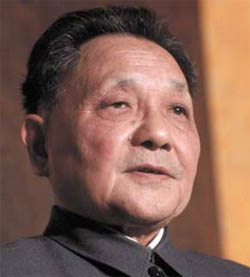
Deng Xiaoping – Resource Visionary?
Conclusions
The world is going through what some have described as a ‘Golden Age of Science,’ but more importantly the combination of scientific advances plus computing power plus Internet communication is allowing science to proceed at an ever faster rate, while the communications via the Internet, twitter and mobile devices such as iPads have increased scientists awareness of other disciplines. The age of microfiches and ordering reprints of journal articles is long gone, which has vastly increased scientific productivity.
New materials and production methods are emerging, some of which have the potential to initially supplement, and possibly replace existing materials and production methods.
While that means that business opportunities based on science and engineering are increasing dramatically, these must be carefully mapped to the addressable markets. We believe that ‘Doing More With Less’ and ‘Replacing Scarce Resources’ represent an irresistible market pull, and something that smart investors will use to channel the fruits of the new scientific renaissance.
See also the Club of Amsterdam blog Sustainable Technologies for the Next Decade
Videos: the future of CERN
Future Retail Center
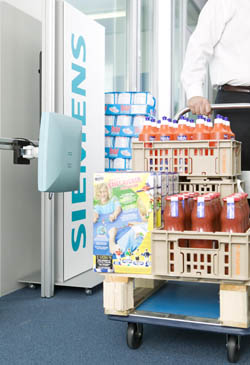
The Future Retail Center, located in Regensdorf, Switzerland, and managed by SAP Research CEC Zurich, is a joint effort between SAP Research and industrial and academic partner organizations to foster research and development in retail, trade, and logistics.
One major goal of the Future Retail Center is to improve the customer experience while optimizing in-store processes with intelligent deployment of IT and SAP systems. RFID, sensor-based systems, and other information and communications technologies enable the complete visibility and traceability of handling units along the supply chain. These systems and technologies can be used to automate and optimize end-to-end processes – generating a tremendous benefit for businesses and customers. As a result, visualization of in-store stock and automatic replenishment processes may be realized in the near future.
The Future Retail Center is divided into three scenarios with unique goals:
Retail
- Enable customers to navigate stores using mobile devices
- Automate stores with automatic stock and replenishment processes
Retail Management
- Manage stores, warehouses, and plants with Smart Vending Machines, controlled remotely or from plants or retail stores, over a digital map
Logistics
- Optimize processes, from the production stage to the store floor, with different solutions along the supply chain
Club of Amsterdam blog
Club of Amsterdam blog
http://clubofamsterdam.blogspot.com
June 16: Deep Diving
June 16: Leadership
May 14: Sustainable Technologies for the Next Decade
May 10: What is the future of natural gas in Europe?
April 8: The Dawn of the Intelligent Planet
News about the Future

Energy Outlook
The Energy Outlook for Asia and the Pacific () aims to estimate, for each of the regional members of the Asian Development Bank (ADB), the future demand for energy, supply options to 2030 for a business-as-usual scenario, investment requirements for meeting this demand, and the resulting CO2 emissions potential associated with increasing energy demand. The Energy Outlook also attempts to identify key issues that need to be considered to mitigate the adverse impacts of the increasing energy demand in the region.

Japanese firm wants to transform the Moon into a giant solar power plant
The Shimizu Corporation, a Japanese construction firm, has recently proposed a plan to harness solar energy on a larger scale than almost any previously proposed concept. Their ambitious plan involves building a belt of solar cells around the Moon’s 6,800-mile (11,000-kilometer) equator, converting the electricity to powerful microwaves and lasers to be beamed at Earth, and finally converting the beams back to electricity at terrestrial power stations. The Luna Ring concept, the company says, could meet the entire world’s energy needs.
Recommended Book

You Are Not a Gadget
by Jaron Lanier
For the most part, Web 2.0 – Internet technologies that encourage interactivity, customization, and participation – is hailed as an emerging Golden Age of information sharing and collaborative achievement, the strength of democratized wisdom. Jaron Lanier isn’t buying it. In You Are Not a Gadget, the longtime tech guru/visionary/dreadlocked genius (and progenitor of virtual reality) argues the opposite: that unfettered – and anonymous – ability to comment results in cynical mob behavior, the shouting-down of reasoned argument, and the devaluation of individual accomplishment. Lanier traces the roots of today’s Web 2.0 philosophies and architectures (e.g. he posits that Web anonymity is the result of ’60s paranoia), persuasively documents their shortcomings, and provides alternate paths to “locked-in” paradigms. Though its strongly-stated opinions run against the bias of popular assumptions, You Are Not a Gadget is a manifesto, not a screed; Lanier seeks a useful, respectful dialogue about how we can shape technology to fit culture’s needs, rather than the way technology currently shapes us.
University of Illinois Scientists Demonstrate Us Little Known Solutions to Create More Effective Photo voltaic panels

by Shannon Combs
Even if silicon is actually the market normal semiconductor in most electronic products, which includes the solar cells that photo voltaic panels use to convert sunshine into power, it is not really the most cost-efficient material on the market. For instance, the semiconductor gallium arsenide and similar compound semiconductors offer nearly two times the performance as silicon in photo voltaic products, however they are rarely employed in utility-scale applications mainly because of their excessive production price.
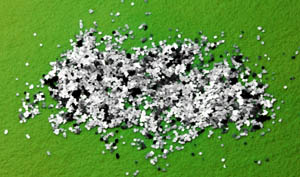
University of Illinois professors J. Rogers and X. Li investigated lower-cost methods to create thin films of gallium arsenide which also granted adaptability in the sorts of products they might be integrated into. If you may lower significantly the expense of gallium arsenide and other compound semiconductors, then you can expand their own range of applications.
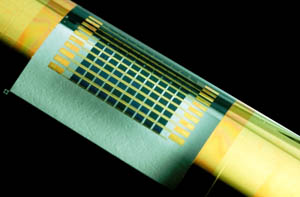
Generally, gallium arsenide is placed in a single thin layer on a smaller wafer. Either the wanted device is created directly on the wafer, or the semiconductor-coated wafer is cut up into chips of the ideal dimension. The Illinois team considered to put in multiple levels of the material on a one wafer, producing a layered, “pancake” stack of gallium arsenide thin films. If you grow ten levels in one growth, you only have to fill the wafer 1 time. If you do this in ten growths, loading and unloading with temperature ramp-up as well as ramp-down get a lot of time. If you consider exactly what is necessary for every growth – the machine, the preparation, the time, the people – the overhead saving this approach presents is a important price decrease. Following the researchers separately peel off the layers and transport them. To complete this, the stacks swap layers of aluminum arsenide with the gallium arsenide. Bathing the stacks in a formula of acid and an oxidizing agent dissolves the levels of aluminum arsenide, freeing the single small sheets of gallium arsenide. A soft stamp-like device picks up the layers, 1 at a time from the top down, for move to another substrate – glass, plastic or silicon, depending on the application. Next the wafer could be used again for one more growth. By executing this it’s possible to produce much more material a lot more quickly and more price efficiently. This process could produce mass amounts of material, as compared to just the thin single-layer way in which it is usually grown. Freeing the material from the wafer additionally starts the possibility of flexible, thin-film electronics produced with gallium arsenide or other high-speed semiconductors. To make units that may conform but still keep higher efficiency, which is significant. In a document written and published online May twenty in the academic journal Nature, the team details its techniques and shows 3 kinds of units making use of gallium arsenide chips made in multilayer stacks: light devices, high-speed transistors and photo voltaic cells. The authors additionally supply a comprehensive cost comparability. One more benefit associated with the multilayer technique is the release from area constraints, especially essential for photo voltaic cells. As the layers are removed from the stack, they can be laid out side-by-side on an additional substrate in order to generate a much bigger surface area, whereas the typical single-layer procedure limits area to the size of the wafer. For photovoltaics, you need large area coverage to catch as much sunshine as achievable. In an extreme situation we might grow enough layers to have 10 times the area of the standard. Up coming, the team programs to investigate more potential item applications and other semiconductor resources which could adapt to multilayer growth.
Shannon Combs publishes articles for the residential solar power systems web site, her personal hobby blog centered on guidelines to help home owners to save energy with solar power.
When Zero means All

Arnab B Chowdhury,
Expert of the Club of Amsterdam
Authors: Rémi Boutinet, Prarthana Kalaskar, Arnab B Chowdhury – Core members, IndiaThinks
IndiaThinks is Ninād’s research arm, which focuses on Strategies that unite Knowledge-Business-Consciousness in harmony. www.ninad.in
“ma 27 ta 54116”, says Gomathi, “is the treatment for this child” and performs it successfully. Success is measured by the width of the smile on the child’s face that reaches the eyes and his/her willingness to come back happily in case some other problem arises. Gomathi, a housewife, is one of the few health hygienists from rural India who have been trained for dental health care. An important element of the small dental care ripple that is revolutionizing life, she works in the villages neighbouring Auroville, Tamil Nadu, (south India). The focus of this programme is training women and primarily treating children: treat the children and train them well in dental care while young and they will have fewer problems when they grow up. The treatment “ma 27 ta 54116” meant filing a cavity of “the second left upper molar filling in occlusal surface with composite”, indeed a unique way of communicating a diagnosis. The treatment and its delivery are unique too!
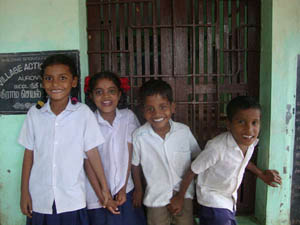
Knowledge owners and stakeholders
This human-centric dental care programme holds enormous potential to be replicated, scaled, sustained and co-opted along with other health care initiatives, globally.
What we have here is a perfect integration of:
- experiential knowledge
- open access for all individuals to this knowledge-practice
- a learning that can be implemented without any discrimination or cultural barriers
- creation of a sense of service to one’s community
- a respectable remuneration with minimal investment
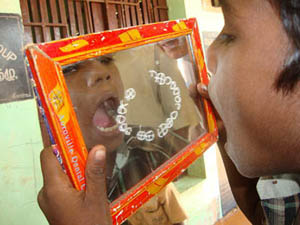
All one needs is a flat surface for the patient to lie upon, a stool for the dental health worker and minimal necessary instruments and materials to perform the basic treatments. In practice, basic treatments can be carried out on the field: in schools, village halls or in health centres with minimum equipment and resources.
The dental health worker is trained by dentists in Atraumatic Restoration Treatment (ART). ART for dental care developed in Tanzania in the mid-80s. The World Health Organisation (WHO) started to actively promote it in the early 90s as the first line of dental treatment in developing countries. ART is an approach for both prevention and treatment of dental caries in children and grown ups. ART equips dental health workers to spot caries early and treat them immediately with minimal tools and infrastructure.
For this particular dental health care programme, the “ART” technique is associated with Zero Concept and Proprioception.
Pedagogy-driven design and practice
Zero Concept and Proprioception
“Backaches and neck pains were the bane of my life” said Dr. Jacques Verré, the founder of the Auroville Dental Care Centre and this programme; “most dentists suffer from them; it is a like a professional hazard. But ever since I learned and started to use Concept Zero and PD during my practice, I have been a happy man. I also taught it to my colleagues. Now my patients, my assistants, fellow doctors and I are free from pains that occur during treatment” (Dr. Verré is a Frenchman settled in Auroville, India). Dr. Amar Raja his colleague at the main Centre, Ms Suryagandhi who heads the rural dental care programme and looks after the main Centre agree with him wholeheartedly.
Dr. Verré’s clinic looks like a Zen temple equipped with some state-of-art gadgets for analysis.
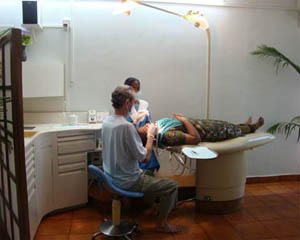
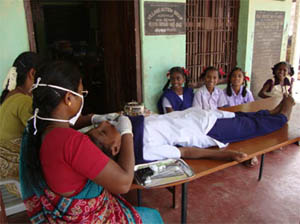
Dental care can be provided anywhere
Zero, an ancient Indian concept, starts with ‘nothing’ (not a thing) — absence of preconceptions or biases. The general idea of Zero Concept is that, for a given condition, there is an elemental or basic condition to which it can be compared to and from which other conditions can be inferred. When applied to health care, health or the absence of need for care is the goal, and is represented by the numeric 0.
Proprioception (‘self-perception’ from Latin) is the self-awareness of the position and movements within our own body. There is an instinctive logical response of our body to perform a precise task for its optimal use. Only a state of body balance (Ø condition) in free space allowing free movements can enhance our manual skills with more accuracy and less tension. This inborn physical perception called “Proprioceptive Derivation” (PD) is not a question of culture but is characteristic of all human beings, a common heritage.
Consciousness approach
Human-centered design
This form of dentistry is the result of a life-long pursuit of a better way to practice dentistry by American dentist, Dr. Daryl Beach, residing in Osaka, Japan. He redesigned the dentistry equipment through Proprioceptive Derivation (PD) to let the body of the performer move freely in open space – avoid stressful positions and useless waste of energy. The best position of the operator’s head, body, and fingers is determined by masked-eye tests using the proprioceptive senses of the body. The proprioceptive senses of the body are used to derive the most ergonomic design of dental equipment and instruments. Typically, one needs about 20 forceps to address ailments of 32 different types of teeth. With this method the need is only for 2!
The result is a new way of performing dentistry!
The relationship of operator to patient is stabilized and consistently keeps the dentist in a full upright alert seated posture behind the head of the patient. The dentist’s upright posture allows the best control of the fine stabilized finger movements required when operating in the mouth and on the teeth positioned at the “zero” point. The patient is offered a lying or full rest position for treatment on a stable horizontal support. The traditional tilting dental chair is of no use as it even jeopardizes the balance of the operator, the operator does not bend over the patient anymore in a stressful posture causing life-long back pain.
Zero Concept of Health is based on “Experience” or “a Sensing” — Proprioception. The concept centers on “knowing” the positions, movements, contacts and discomfort that we sense within our bodies as both providers and receivers of care. The scope of concerns includes derivation of all acts, space and human interface with technology in clinics, hospitals or field care for achieving desired outcomes.
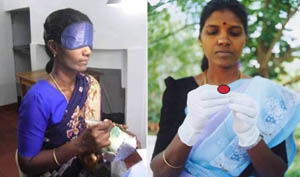
Thus Zero Concept and Proprioceptive Derivation (PD) can be applied to the entire range of health care pursuit and Life in general. However, there is still a long way to go for this concept to reach out and be accepted in the conservative world of dentistry.
Knowledge-based sustainability approach for Health Care
- Positive health is in extending the knowing to doing
- Knowledge (expressed and latent) is an asset
- Shared knowledge and collaborative action foster “health equities”
- Equities “hold and carry” value – emotional and tangible
- Losses are to be seized as occasions for learning in real time
- Profits are to be measured in terms of larger, intense and long-term impacts measured over a generation of population
Language for Outreach:
Although innovative and universal, this concept disrupts the traditional habits and thoughts and perhaps the present business model and profit-seeking motivation of the equipment manufacturers. Resistance to Zero Concept and Proprioceptive Derivation (PD) also stems from a lack of knowledge about the technique and the acceptance of the concept of minimal intervention.
This way of doing dentistry is being practiced by very few dentists and these dentists are scattered throughout the world.
Dr. Beach developed a syllabo-numeric language for easy and precise communication. The global terms, which can be both written and spoken, use the most common syllables in the world (ma, me, mi, mu, mo, ta, te, to…) in combination with digits. The numeric 0 is the basic reference for easy codification and classification of information. Example: the lingo “ma li le”, also written “ma 21”, designates the upper left incisor. In this case, “ma” means the mouth in its xyz coordinates, li or 2 means the first quarter (upper left) and, le or 1 means the first teeth of the quarter. The jaws are indeed numbered clockwise into four intuitive quarters.
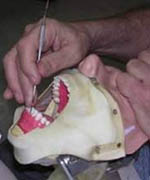
Description: Tip of the third right finger on the lower right canine on the vestibular surface
More advanced example sited earlier is for a treatment: “ma 27 ta 54116” means “the second left upper molar filling in occlusal surface with composite”. This means, all dentists (no matter which country they belong to or the dental courses they have studied) and even a hygienist who has no scientific background, can record her work and can communicate without misunderstanding. The Global Terms are learnt together with the PD exercises.
Gains without Pains: A win-win for all!
Gain from the care provider’s perspective:
- The programme is based on the universal ‘Zero(Ø) Concept’, a reasoning applied to Proprioceptive Derivation (PD) and is easy to learn
- Recognised as para-medical training programme, the Atraumatic Restoration Treatment (ART) is promoted by the WHO for developing countries where local population is trained to deliver basic dental care
- The health workers are trained in the Zero Concept reasoning, which consists of a series of self-awareness exercises aimed at finding out one’s preferred body conditions.
- A syllabo-numeric terminology to describe various dental conditions and their treatment help the dental health workers to overcome language barriers
- Thus equipped, the health workers can perform basic treatments in the most efficient way
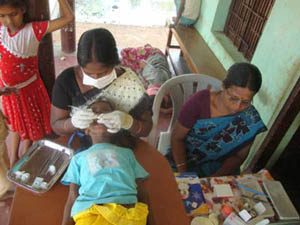
Gain from the care receiver’s perspective:
- Location for treatment can be a school verandah, temple hall or even under a tree. Simple natural settings drives away fears of visiting a dentist/dental worker
- Prevention is key: simple and early cares prevents tooth extraction, pain, painful treatment, expenses
- The care provider belongs to the same community and is easily accessible, this induces a willingness to get the treatment
- Timely treatment is almost pain free and encourages the young and old to seek it, besides it reduces further deterioration of dental problems
- Costs for basic treatment are minimal and therefore affordable.
Knowledge Practioners as Outreach Agents
Simplicity of technique arouses curiosity among children who then become potential care-providers, confirming the sustainability loop from the human resource point of view.
As of now about 20 women dental health workers across 10 sub-centres cater to a population of 25,000 individuals of varying ages and at various stages of tooth problems. Complex cases are attended to by dental surgeons at the main Centre. This is in stark contrast to the picture that one finds in India where some 700 million people have poor or no access to dental care and most of this population resides in the country’s rural areas. Good dental care is expensive, besides a dentist can hardly make a living as a dentist in rural areas.
Health needs to be seen as Wealth. This can become possible when explicit knowledge is translated into strategy and action, creating value that leverages tacit knowledge especially when stakeholders consciously choose to be collaborative, as is the case with this programme.

Women, intrinsically, are holistic care-providers. By training them as dental health workers their intrinsic nature finds a happy expression making them dynamic, confident and innovative while delivering health care. Their status as professional heath care workers raises their self-esteem in the family, their community and among local governance bodies. They are accepted for what they are; sparkling toothy smiles are the new measure of success!
Smaller but conscious organizations like self-help groups and entrepreneurs need to base their sustainability by managing knowledge and knowledge resources (in this case-women) even more, because they lack the market leverage and resources of their larger counterparts. They have to be more nimble, responsive than reactive, take timely and more “right” decisions and use appropriate communication strategies- for, their survival depends on it.
“You are what you eat;” says Suriyagandhi, “if you cannot chew your food properly you will have poor digestion and therefore poor health. Poor health will affect your whole life and your family will suffer too!” The logic is quite simple.
Futurist Portrait: Michio Kaku

Dr. Michio Kaku is a theoretical physicist, professor, futurist, best-selling author, and popularizer of science. He’s the co-founder of string field theory (a branch of string theory), and continues Einstein’s search to unite the four fundamental forces of nature into one unified theory.
He has appeared on television (Discovery, BBC, ABC, Science Channel, and CNN to name a few), written for popular science publications like Discover, Wired, and New Scientist, been featured in documentaries like Me & Isaac Newton, and hosted many of his own including BBC’s recent series on Time.
Theoretical Physicist – Dr. Michio Kaku is the co-creator of string field theory, a branch of string theory. He received a B.S. (summa cum laude) from Harvard University in 1968 where he came first in his physics class. He went on to the Berkeley Radiation Laboratory at the University of California, Berkeley and received a Ph.D. in 1972. In 1973, he held a lectureship at Princeton University.
Michio continues Einstein’s search for a “Theory of Everything,” seeking to unify the four fundamental forces of the universe – the strong force, the weak force, gravity and electromagnetism.
He is the author of several scholarly, Ph.D. level textbooks and has had more than 70 articles published in physics journals, covering topics such as superstring theory, supergravity, supersymmetry, and hadronic physics.
Professor of Physics – He holds the Henry Semat Chair and Professorship in theoretical physics at the City College of New York, where he has taught for over 25 years. He has also been a visiting professor at the Institute for Advanced Study at Princeton, as well as New York University (NYU).
Kaku believes that the very future of the human race is on the line. “We’re at a precipice; we are experiencing the birth pangs of a ‘Type 1 Civilisation’. And there’s no guarantee we’ll make it.”
Kaku defines a Type 1 civilization as one that is truly a planetary society, who has mastered all forms of terrestrial energy. Their energy output is much greater than ours.
“Black holes distort this fabric of space-time maximally, and you can show that black holes can be time machines,” Kaku said. “If you go through a black hole, in principle, you can go to another point in space-time, just like [the fictional] Alice’s looking-glass.”
“We want to push the laws of physics until they break,” explained Kaku. “Because that’s where you make new discoveries, by looking at where the old theory breaks down.”
“Some people think, ‘Well, maybe a backyard inventor may invent a time machine,’ ” said Kaku. “I don’t think so – I don’t think a backyard inventor’s going to find a time machine anytime soon.”
“I’d actually prefer to go to the future. You know, nature gives you a finite life span, but all the good stuff – antimatter drives and parallel universes – takes place beyond your lifetime. So, I want to see beyond my years.”
Part 1



Customer Reviews
Thanks for submitting your comment!